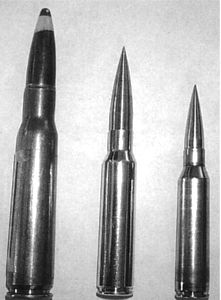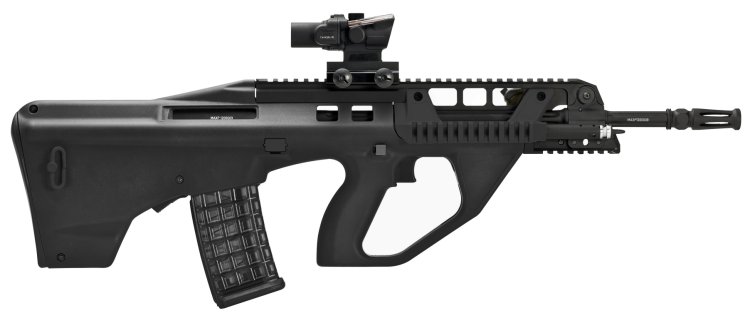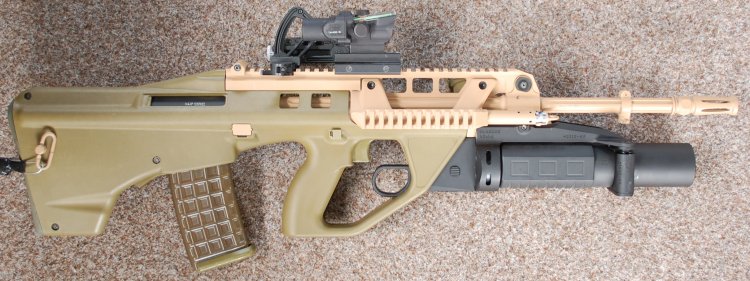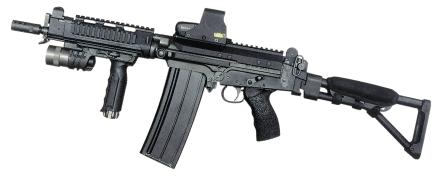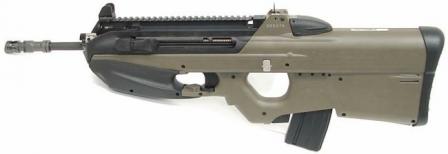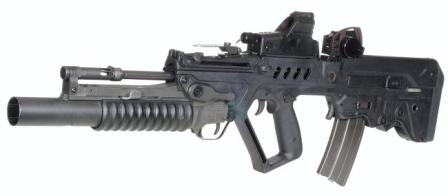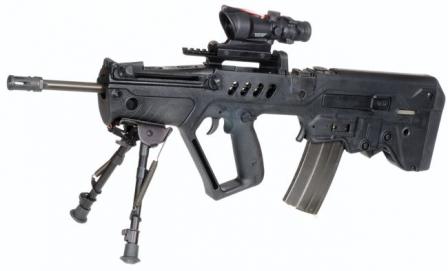RPA
| Caliber | .50 BMG / 12.7x99 |
| Operation | manually operated bolt action |
| Barrel | 812 mm (32") |
| Length (ready / folded) | 1520 / 1230 mm (60" / 48") |
| Weight, w. bipod and scope | 16.9 kg (37.3 lbs) |
| Feed Mechanism | 5 rounds detachable box magazine |
British rifle-making company RPA Precision Ltd (now RPA International
Ltd) originally built indigenous target rifles, and entered "tactical
rifle" market in 2001 with new 7.62mm "Range master"
sniper rifle, based on proprietary RPA Quadlock® action, used in their
match rifles. The 7.62mm "Range master" rifle was soon supplemented with
long range anti-personnel .338Lapua version in 2004, and long range /
anti-material .50 caliber version in 2005. According to the
manufacturer, RPA "Range master"rifles are in active use with a
significant number of police and security organizations across the
world. With proper ammunition, all RPA "Range master" rifles are capable
of constant sub-MOA accuracy.
RPA "Range master" sniper rifles are built around proprietary Quadlock®
action,which features manually operated rotary bolt with four frontal
radial lugs. Barrels are fluted for better heat dissipation, and
threaded to accept a muzzle brake or silencer. Triggers are of two-stage
type,fully adjustable, with ambidextrous manual safety conveniently
located just above the trigger. Rifles are fed using detachable box
magazines holding five rounds. Stock is of composite (aluminum+ polymer)
design, with side-folding butt which is adjustable for length of pull.
Unusual features of the RPA stock design are bolt channel, which also
serves as the stock comb / cheek rest, and the fact that in emergency
situations rifle can be fired with butt folded. RPA "Range master"sniper
rifles are sold without any iron sights, and equipped with
standardPicatinny rail on the receiver which can accept a wide variety
of day or night sighting equipment. Two additional lengths of Pica tinny
rail are installed on the for end. Other accessories include
folding adjustable bi pod and adjustable mono pod, built into the
butt stock.
Barrett Model M90 and M95 (USA)
data for Barrett M95 rifle
Caliber: .50 BMG (12.7 x 99mm)
Operation: Bolt Action
Overall Length: 1143 mm
Barrel Length: 737 mm
Feed Device: 5 Round Detachable Box Magazine
Sights: 10X Telescopic
Weight: 9.98 kg empty, without scopeљ
Muzzle Velocity: 854 m/s (M33 Ball)
Expected accuracy: about 1 MOA or better with match grade ammunition
Maximum Effective Range: about 1800 meters (depending on the environment conditions and the target)
The M90 rifle was developed in 1990 by the American company Barrett
Firearms co for those customers who want or needed a .50 caliber rifle
but prefer a bolt action instead of the semi-automatic design, offered in
the Barrett's' flagship model, M82A1.
The new rifle also was lighter and some30 centimeters (12") shorter
than the M82A1, and also about 30% less expensive (comparing current MSRP
of M82A1 and M95). After initial experience with this rifle it was
replaced in production in 1995 by the slightly upgradedM95 model rifle,
which is still in production. It is used by civilian long
range competition shooters across the world, and by various military and
law enforcement forces. It is not so popular across the government users,
unlike the Barrett M82A1. In the year 1999 the M95 won the US Army
competition for XM-107.50 caliber sniper rifle, and was subsequently
bought by US Army in small number for further research and testing. The
Barrett website also announces that M95rifle is used for military and
law enforcement applications in at least 15 other countries. Like the
M82A1, the M95 primary application are anti-materiel and counter-sniper
operations and explosive ordnance disposal.
M90 is a manually operated, bolt action rifle of bull pup layout. The
rotating bolt has three massive lugs that locks directly into the barrel.
The long fluted barrel is similar to one used in M82A1 rifle and has the
same two chambers reactive muzzle brake. The receiver is made from
stamped sheet steel and consists of two parts(upper and lower),
connected by the push-pins. The detachable box magazine is shallower than
one found on M82A1 rifles and holds only 5 rounds. The pistol handle ant
the trigger are located just ahead of the magazine, the butt pad
is attached directly to the receiver. M90 has no open iron sights, but
features as cope mount on the top of the receiver. It is most commonly
fitted with 10XLeupold M series telescope sights. M90 does not intended
to be fired from the shoulder, and it has integral folding bi pod mounted
on the front end of the lower receiver.
The M95 is an improved version of the M90. It featured pistol handle
and the trigger unit moved forward for 1 inch (25 mm) for
better clearance between the magazine and the pistol grip, and thus more
comfortable handling and shooting. The bolt handle is slightly redesigned
and bent down and to the rear. The barrel chamber is chrome plated for
better extraction and corrosion resistance. There are also some minor
improvements in the trigger /firing pin mechanism.
HK PSG-1.

Close-up on the PSG-1 receiver. Note adjustable shoe on the trigger, adjustablecheekpiece, "silent bolt closing device" push button just behind the ejection port.
Caliber: 7.62 x 51mm NATO (.308 Win)
Action: Semi-automatic, roller-delayed blow back
Barrel: 650 mm
Overall length: 1208 mm
Weight: 8.10 kg with scope and no magazine
Magazine: 5 or 20 round detachable box
Scope: Hendsoldt 6x42, 6 settings from 100 to 600 meters
Expected accuracy: Sub-1MOA with match grade ammunition
The PSG-1 sniper system (PrazisionsSchutzenGewehr, or "high-precision
marksman's rifle"in English) had been developed by the German company
Heckler - Koch by the mid-1980s as an ultimate police and counter-terror
weapon. Some German elite law-enforcement groups, like GSG or KSK-9,
participate in this development, and since its introduction the PSG-1 had
been adopted by various police forces in Europe and Americas. It is way
too heavy and somewhat too gentle for military use, so it never seen any
military use. Instead, HK developed two more sniper weapons. The first,
that actually preceded the PSG-1, was the G3-SG1, an accurizedand
scope-fitted version of the basic G3 automatic rifle for German Army. And Ianthe mid-1980s HK also developed a derivative of the PSG-1, called MSG-90,
for export military sales. The PSG-1 is still offered by the HK, and is
one of the most expensive factory-made sniper rifles on the market,
hitting the $10.000price tag in the basic package.
Technically, the PSG-1 is no more than a heavily modified G3 rifle. It
features the same roller-delayed blow back action, derived from earlier
CETME rifles, and the same stamped steel receiver with separate
detachable trigger unit. The heavy barrel is precisely made by the cold
hammer forging process with polygonal rifling for improved accuracy and
longer life. Special trigger unit features semi-automatic only hammer
group and the adjustable trigger with trigger pull of about 1.5 kg (3
lbs). The ergonomically shaped pistol grip features an adjustable palm
stop. Plastic butt stock is also adjustable for height and for length of
pull. Another non-typical feature of the PSG-1 is the "silent
bolt closing device", actually similar to the forward assist, found on
M16rifles. This is apparently to be used in situations where a complete
silence must be maintained until the shot is fired. The devise is no more
that apushbutton, located just behind the ejection port, and linked to
the bolt carrier by the ratchet-like device. The rifle is fed using
standard 20-rounds G3magazines or special 5-rounds magazines. There's no
open (iron) sights on thePSG-1. Instead, it is fitted with the
Hendsoldt 6X42 fixed power telescope sight with illuminated reticle. The
scope has built-in range adjuster that works in ranges from 100 to 60
meters, so 600 meters is considered the maximum effective range. Most
strangely, the PSG-1 had no integral bi pod. Instead, it is often used
with the separate rest, mounted on the compact tripod.
CheyTac Long Range Rifle System - Intervention sniper rifle (USA)

CheyTac LRRS, including Intervention M200 rifle with scope, .408 CheyTac ammunition, and tactical ballistic computer.

Close-up view on the receiver and controls of the CheyTac Intervention M200rifle. Note large carrying handle under the barrel sleeve, and the scope fitted with IR night vision module and IR laser.
Caliber: .408 CheyTac
Operation: manually operated rotating bolt action
Barrel: 762 mm (30")
Weight: 12.3 kg
Length: 1400 mm (stock retracted), 1220 mm (stock collapsed)
Feed Mechanism: 5 rounds detachable box magazine
The entire idea behind the CheyTac LRRS (Long Range Rifle System) is to
provide long range soft targetinterdiction (read: anti-personnel sniper)
rifle package, with maximum effective range, but relatively compact and
light. To achieve this goal, the professor John D. Taylor designed the
.408CheyTac cartridge. Being mid-way in size between the mighty .50BMG
and already established long-range favorite .338Lapua, the .408 features a
streamlined bullet with advanced patented design. This design allows the
standard 419 grain (27.15gram) bullet to retain its supersonic
velocity at the ranges beyond 2000 meters (2200 yards). At the ranges
beyond 700 meters the .408 bullet has more energy than the standard
.50BMG ball bullet. The .408 cartridge also is lighter than.50BMG
cartridge by about 1/3, and generates less recoil.
The original CheyTacIntervention M100 rifle is based on the Wind runner
.50 caliber take down rifle fromEDM Arms. Current Intervention M200
sniper rifles still are based on Windrunnerdesign, but with several
modifications. The Long Range Rifle System also includes CheyTac
tactical computer (commercial PDA with Cheetah ballistic software),
Night force NXS 5.5-22X scope, and Kestrel 4000
wind/temperature/atmospheric pressure sensors, linked to the PDA. The
Tactical Computer with sensors andinternal ballistic database provides
all necessary data for long range fire.CheyTac papers state that the
entire System is capable to deliver sub-Accuracy at the ranges of up
to 2500 yards (2270 meters).
The Intervention M200is a manually operated, rotating bolt rifle. The
retractable buttstock allowsfor adjustment of the length of pull, and
can be fully collapsed for storage andtransportation. The barrel can be
quickly removed for replacement, or storage and transportation. The butt
contains integral real monopod, which is hinged,and can be folded up
when not in use. The heavy, fluted barrel is free floated,and its rear
part is enclosed by tubular shroud, which serves as a mount for integral
folding bi pod and carrying handle. Barrel is provided with
effective muzzle brake, which can be replaced with OPS INC suppressor
(silencer). M200rifle is fed using detachable single stack magazines,
which hold 5 rounds. Top of receiver is fitted with permanent Mil Std
Pica tinny rail. Standard scope is Nightforce NXS 5.5-22X, which can be
upgraded with AN/PVS-14 Night Vision module and AN/PEQ-2 IR laser. No
iron sights are provided with M200 rifle.
CheyTacAssociates also offers a less expensive, non-take down single
shot rifle in .408caliber, the Intervention M310. This bolt action rifle
with adjustable polymer stock is suitable for long range sport shooting,
as well as for police long range snipers.
data source: CheyTac Associates Technical White Papers, 2001-2003, and CheyTac promotional literature.









